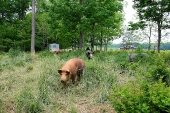Kevin MacBearach wrote:What do others here do for the pigs food? I have pasture and lots a brambles for a paddock shifting system but that's about it so far. I'm kind of leary about scraps from restaurants and want to be as organic as possible. Maybe farmers markets?Suggestions??
We pasture about 400 pigs from breeding through finishing. Our pastures are the vast majority of their diet. Once winter snows set in we are up off the ground now ice pack until spring so we replace the pasture with
hay on winter paddocks. We are using managed rotational grazing techniques adjusted for our herds, seasons, terrain, soils and climate. We buy no commercial grain feed (e.g., corn/soy, etc) for our pigs.
We supplement the pasture/hay with
dairy which is almost all whey from making cheese, yogurt and butter.
We also grow a lot of pumpkins, sunflowers, beets, kale, rape, turnips and such no-till in our winter paddocks and out in the grazing fields.
We plant a variety of legumes including clovers, alfalfa, trefoil, etc to suck free nitrogen fertilizer down from the sky and
boost the protein of our forages.
We get a small amount of other inputs such as a little day old bread and spent barley from a
local bakery and brew pub but that is infrequent and doesn't go far with 50,000 pounds of pigs. Fortunately pigs really do eat pasture because that is what we have in an essentially unlimited amount. They thrive on it.
See these articles:
http://SugarMtnFarm.com/2013/05/25/vermont-planting-weather/
http://www.google.com/search?q=site:sugarmtnfarm.com+rotational%20grazing
http://www.google.com/search?q=site:sugarmtnfarm.com+feeding
http://www.google.com/search?q=site:sugarmtnfarm.com+feeding%20whey
I would strongly suggest not using restaurant scraps or school scraps or any other form of post-consumer wastes. It may be illegal where you are and it runs biosecurity risks as well as the possibility of broken glass and cutlery mixed in which could hurt the pigs. Stick with pre-consumer wastes like pumpkins in the end of the fall, sweet corn that didn't
sell, etc. Learn to grow as much as you can for your livestock. That is the best food.
We also keep a lot of
chickens for their organic pest control ability. As a side benefit they produce a lot of eggs from our pastures which we cook and feed to our younger weaner, shoat and grower pigs. Cooking doubles the available protein and those ages are the ones that benefit the best from this bonus. Look for systems like this that can integrate on your farm to produce multiple functions.
Our pigs chow down on thistles, brambles and burdock. Some of their favorites. Clover is high on their list of foods. Move animals based on parasite life cycle breaking and forage growth rates. Stay out for >21 days, Move <18 days, preferably a lot less to avoid soil compaction but depending on numbers of animals and size of paddocks. Let paddocks rest when they can seed at least once a year or two to replenish the seed bank.
Cheers,
-Walter Jeffries
Sugar Mountain Farm
Pastured Pigs, Sheep & Kids
in the mountains of Vermont
http://SugarMtnFarm.com/
































































 1
1
































